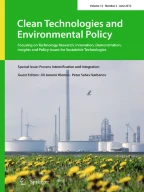Abstract
Based on the Seebeck effect, thermoelectric generators can convert thermal energy directly into electrical power, which can be applied in waste heat recovery and clean energy generation. In this work, segmented thermoelectric legs were prepared with high-performance thermoelectric materials for the fabrication of multistage thermoelectric generators, which can be utilized in medium temperature energy harvesting. The P-type leg material was Pb0.94Sr0.04Na0.02Te/Bi0.5Sb1.5Te3, and the N-type leg material was Pb0.94Ag0.01La0.05Te/Bi2Te3. The length ratio of the two segments was optimized based on the energy conversion efficiency under different working conditions. The segmented legs were measured with the four-probe method at different temperatures to evaluate their output performance. At a temperature difference of 420 K, the maximum output power density was 0.40 W/cm2 for the P-type leg and 0.32 W/cm2 for the N-type leg.
Similar content being viewed by others
References
Baranowski LL, Warren EL, Toberer ES (2014) High-temperature high-efficiency solar thermo- electric generators. J Electron Mater 43(6):2348–2355
Bell LE (2008) Cooling, heating, generating power, and recovering waste heat with thermoelectric systems. Science 321:1457–1461
Biswas K, He J, Blum ID et al (2012) High-performance bulk thermoelectrics with all-scale hierarchical architectures. Nature 489:414–418
Cook BA, Chan TE, Dezsi G et al (2014) High-performance three-stage cascade thermo- electric devices with 20 % efficiency. J Electron Mater 44(6):1936–1942
Crane DT, Kossakovski D, Bell LE (2009) Modeling the building blocks of a 10 % efficient segmented thermoelectric power generator. J Electron Mater 38:1382–1386
D’angelo J J, Case ED, Matchanov N et al (2011) Electrical, thermal, and mechanical characterization of novel segmented-leg thermoelectric modules. J Electron Mater 40:2051–2062
Disalvo FJ (1999) Thermoelectric cooling and power generation. Science 285(5428):703–706
Glaser JA (2014) Green money laundering. Clean Technol Environ Policy 16:675–680
Hsu KF, Loo S, Guo F et al (2004) Cubic AgPbmSbTe2+m: bulk thermoelectric materials with high figure of merit. Science 303:818–821
Hu XK, Jood P, Ohta M, Kunii M et al (2015) Power generation from nanostructured PbTe-based thermoelectrics: comprehensive development from materials to modules. Energy Environ Sci. doi:10.1039/c5ee02979a
Liu D, Li Q, Peng W, Zhu L, Gao H, Meng Q, Jin AJ (2015a) Developing instrumentation to characterize thermoelectric generator modules. Rev Sci Instrum 86:1–6
Liu WS, Jie Q, Kim HS, Ren ZF (2015b) Current progress and future challenges in thermoelectric power generation: from materials to devices. Acta Mater 87:357–376
Moffat R (1997) Notes on using thermocouples. Electron Cool 3:1
Mohamed S, Hamed EG, Saber H (2003) High efficiency segmented thermoelectric unicouple for operation between 973 and 300 K. Energy Convers Manag 44:1069–1088
Muller E, Drasarl C, Schilz J, Kaysser WA (2003) Functionally graded materials for sensor and energy applications. Mater Sci Eng A 362:17–39
Nolas GS, Sharp J, Goldsmid HJ (2011) Thermoelectrics: basic principles and new materials developments. Springer, London
Park K, Lee GW (2011) Thermoelectric properties of Ca0.8Dy0.2MnO3 synthesized by solution combustion process. Nanoscale Res Lett 6:1–5
Snyder GJ (2004) Application of the compatibility factor to the design of segmented and cascaded thermoelectric generators. Appl Phys Lett 84:2436–2438
Thomson W (1851) On a mechanical theory of thermoelectric currents. In: Proceedings of the Royal society of Edinburgh, pp 91–98
Tian H, Jiang N, Jia Q, Sun X, Shu G, Liang X (2015) Comparison of segmented and traditional thermoelectric generator for waste heat recovery of diesel engine. Energy Proc 75:590–596
Tritt TM (2008) Thermoelectric phenomena, materials, and applications. Annu Rev Mater Res 41:433–448
Tritt TM, Böttner H, Chen L (2008) Thermoelectrics: direct solar thermal energy conversion. MRS Bull 33:366–368
Ursell TS, Snyder GJ (2002) Compatibility of segmented thermoelectric generators. In: 21st international conference on ‘Thermoelectronics’, pp 412–417
Villar A, Arribas JJ, Parrondo J (2012) Waste-to-energy technologies in continuous process industries. Clean Technol Environ Policy 14:29–39
Wojciechowski KT, Zybala R, Leszczynski J et al. (2012) Performance characterization of high-efficiency segmented Bi2Te3/CoSb3 unicouples for thermo- electric generators. In: 9th European conference on thermoelectric, pp 667–470
Yoon S, Cho J-Y, Koo H, Bae S-H, Ahn S, Kim GR, Kim J-S (2013) Thermoelectric properties of n-Type Bi2Te3/PbSe0.5Te0.5 segmented thermoelectric material. J Electron Mater 43(2):414–418
Zhao D, Tian C, Tang S et al (2010) Fabrication of a CoSb3-based thermoelectric module. Mater Sci Semicond Process 13:221–224
Zhao LD, Lo SH, Zhang Y et al (2014) Ultralow thermal conductivity and high thermoelectric figure of merit in SnSe crystals. Nature 508:373–377
Zhou H-Y, Zhao W-Y, Liu G, Cheng H, Zhang Q-J (2012) Design and optimization of gradient interface of p-Type Ba0.3In0.3FeCo3Sb12/Bi0.48Sb1.52Te3 thermo- electric materials. J Electron Mater 42(7):1436–1442
Acknowledgments
This work was funded by the research program for “the one-thousand-global-talents recruitment” grantor of the China Huaneng Group, research, and application of double-stage thermoelectric technology.
Author information
Authors and Affiliations
Corresponding author
Rights and permissions
About this article
Cite this article
Liu, D., Peng, W., Li, Q. et al. Preparation and characterization of segmented stacking for thermoelectric power generation. Clean Techn Environ Policy 18, 1203–1210 (2016). https://doi.org/10.1007/s10098-015-1088-5
Received:
Accepted:
Published:
Issue Date:
DOI: https://doi.org/10.1007/s10098-015-1088-5
